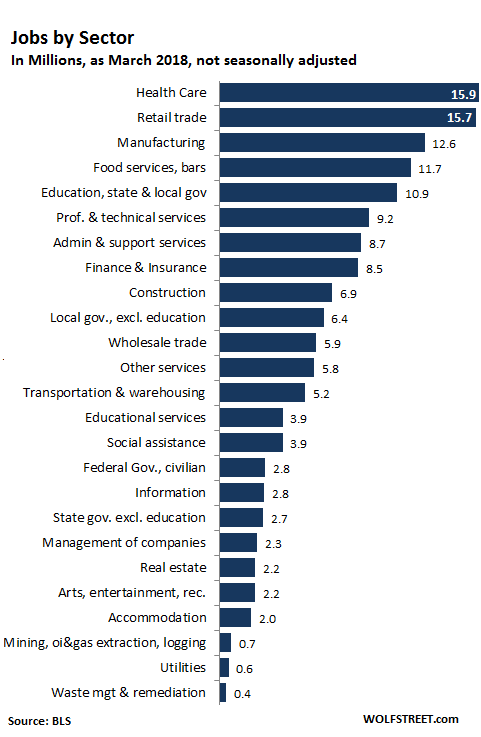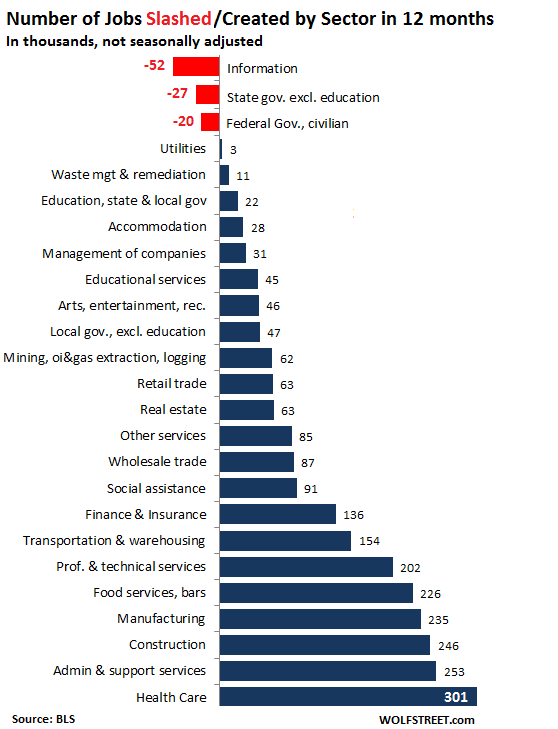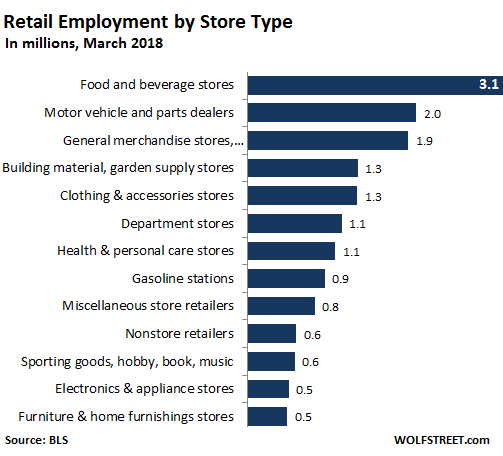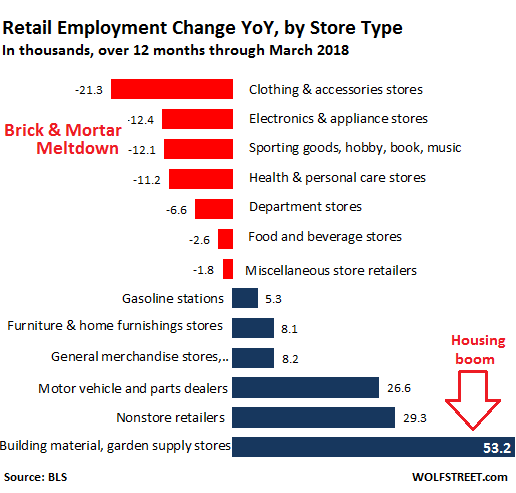Which sectors created 2.2 million jobs in 12 months? Brick & mortar melts down. Governments shed jobs too, even information tech.
In the jobs report today, the Bureau of Labor Statistics provided a trove of granular data on which industries and governments created jobs over the past 12 months, and which destroyed jobs – with some counter-intuitive results.
I have lumped education jobs at state and local governments into one category to get a better feel for employment in education. I titled this category in my creative manner, “Education, state & local gov,” the fifth largest category, with 10.9 million workers. Employment by state and local governments is then shown “excluding education.”
The Federal government, with a payroll of 2.8 million people, is way down on the list. It may be the largest single employer in the US, but it’s not the largest sector. The military is not included. But it includes the shrinking postal service, which accounts for about 28% of civilian federal employment. The USPS payroll shrank by 10,500 people over the past year.

Retail trade, with 15.7 million jobs, is the second largest sector, just behind healthcare, but ahead of manufacturing, which is in third place. So what about Amazon?
Amazon is a big retailer, but it’s also a big tech company with activities that are unrelated to retail, such as its cloud division AWS or its product design shops. It has a gargantuan logistics operation with warehouses around the country. It’s a media company with its own original content. And on and on. So how does its payroll fit into the survey by the Bureau of Labor Statistics, whose results were released today?
The BLS collects the payroll survey data by location. An Amazon “fulfillment center” showing up in the survey would be categorized as “warehousing.” The tech divisions would be located in office parks and categorized as “information services,” and so on. This is the same for Walmart or Macy’s or any of the other retailers that have large online (tech) divisions, warehousing operations, and other entities. Some retailers, such as Walmart or Safeway, have their own fleet of trucks, and the jobs at those locations are classified under trucking.
On the above chart, you can find a category for “management of companies,” which employs 2.3 million people. Bezos would be in that category, as would be lower level managers. So the payroll of a giant company like Amazon gets picked up in the survey by location in bits and pieces and gets spread over numerous categories.
And here’s how these industries and payroll categories have developed their payrolls, either slashing or adding jobs over the past 12 months:

That information technology has been bleeding jobs over the past 12 months might surprise some people. This is a category with 2.8 million workers in March, but that’s down by 52,000 from a year ago. This decline doesn’t go well with the common theme that there are not enough tech workers in the US to fill the jobs.
But many of these tech jobs are at companies that are not tech companies per se. And they routinely outsource their tech jobs to India and other places, or they put them on the chopping block when the cost-cutting gets going. Also, many old-tech companies, such as Microsoft, Cisco, Oracle and many others go through waves and waves of job cuts, especially as they try to extract “efficiencies” out of their flopped acquisitions.
In the chart above, the category, “admin & support services,” with 8.7 million jobs, is comprised of people who keep companies glued together. It created 253,000 jobs over the past 12 months, the second highest tally, after healthcare.
Construction and manufacturing were in third and fourth place, each creating well over 200,000 jobs over the past 12 months.
Even “retail trade” has added 63,000 jobs over the past 12 months. This doesn’t go well with the “brick-and-mortar meltdown.” Or does it?
Part of the retail industry is in upheaval and deteriorating rapidly, while the other part (online) is booming. So we need to look at the granular detail by store type (chart below).
The largest store category is “food and beverage stores,” employing 3.1 million people. “Motor vehicle and parts dealers” employ 2.0 million people. Both of those categories are still considered online resistant. “General merchandise stores” (the rest of the label was cut off in the chart) also includes warehouse clubs and supercenters. This is the category where Costco, Walmart, and Sam’s Club are. But remember, these jobs are only the employees at the stores, not the corporate types, tech workers, warehouse workers, and truck drivers.

And here is what happened to those jobs over the past 12 months. In the chart below, the brick-and-mortar meltdown sectors are market in red. Over the past 12 months, they’ve shed nearly 70,000 jobs. These are precisely the stores that have been the heroes in my articles about store closings, bankruptcies, and layoffs, including Toys ‘R’ Us, Claire’s, Sears, Bon Ton, Sports Authority, and on and on….

The key part about the unemployment rate the BLS released today is that it’s not an absolute measure of unemployment, was never designed to be that, and shouldn’t be looked at as such. It’s an indicator of trends in the labor market: is it going up or down? As such, it works reasonably well. But it fails as an absolute measure of unemployment – and yet, that’s the primary role it has been shanghaied into by the media coverage of the labor market. So here I’m looking at what’s behind the numbers. Read… The Jobs Report, Sliced and Diced
Enjoy reading WOLF STREET and want to support it? You can donate. I appreciate it immensely. Click on the mug to find out how:
![]()


Concerning some of the counter intuitive results: While brick and mortar retail is declining, food and beverage retail may indeed be expanding due to food trucks. Some of the food trucks have a following and apps where you can follow them.
A couple of weeks ago, we attended an event at a neighborhood mall. The attraction was food trucks and free music. The event was extremely well attended, the food truck lines went on forever, the mall restaurants were also busy, the stores were mostly empty.
As an aside: Just read Nine West declared bankruptcy. In my town a commercial REIT (770K sf) housing the cable company and others, with a 68% occupancy, just went bust too.
Wolf, a great drill-down! It’s surprising in a positive way, for me anyway.
Thanks.
“Info tech” is bloated with too many sales people. I went to the AWS Summit in San Francisco just this past Wednesday. It’s amazing the number of people that have been hired to man booths and give away stuff.
The infotech industry is mature – it has been any number of years into the “commoditization” phase where margin/profit, or conversely overhead/expense, is squeezed out, prices trend towards a small margin over actual cost, and markets for specialized products are consolidated.
This has happened to every new major industry ever – just consider how good an machinist job in the 60s was – replaced by CNC. What auto dealership would write its own accounting software – there are vendors out there that sell specialized products. This applies across the board.
BUILDING software is a much different game that MAINTAINING software. Technology is inherently deflationary and trends that way over time. Folks are still going to have jobs and make money, but only those with truly special skills will earn a premium.
This explains the hard on for H1Bs, as that commoditized IT job that still needs to get done to support a mature product could be staffed by someone willing to just work more hours for less money.
Regards,
Cooter
Which is why the H1-B system is a huge scam. Americans should be working those support positions, but instead we get the lie from the companies and from congress that there’s a shortage of technical workers, so they can bring in foreigners on the cheap to do a job Americans were already doing but were laid off from.
Even support positions require technically skilled candidates with strong programming background. Unfortunately America does not have enough graduates in STEM who are willing to work in support positions. Most STEM graduates from US Schools want to become the next billionaire and not work in support jobs earning middle class wage.
The Romanian version of h1b is intresting. You pay 4x the national median salary ($107,846 a year in US terms) since top coders are worth 10x. paying 4x salary and 4x taxes is still a net win and cheap replacement is prevented. Yet shortage workers can still be brought in. Since it is calculated by the census bureau each year, it adjusts foe immigration and inflatiin. Suggesting it to companies and senators would be interesting just to see their reactions
You can’t judge an industry by a trade show, which will always be dominated by marketing people trying to sell their wares.
Just wait till Aldi takes buisness from Amazon. Their Bounty is better than Bounty.
No mention of the elephant in the room.
Healthcare employment is the biggest pie on the chart, and for what? To provide the world’s worst healthcare SYSTEM on planet Earth. A system so bad, American life expectancy has decline 2 year in a row – a probable sign of severe policy failure.
We know form freedom of information act law suits against the Obama White House that Obamacare was designed specifically by Obama to enrich rich gigantic insurance and drug companies and their CEO’s, by denying Americans healthcare.
Maybe that helped trickle down an increase in employment in the World’s Worst Healthcare System.
Yes, it (medical) is a poor product and is often recognized as such. However, because of strict ideaology and the power that health care lobbiests exert over all levels of US Govt., it is unlikely to change its’ standing or practices anytime soon. Therefore, a career in healthcare would be my first recommendation to someone starting out. The population is growing and getting older, it is a captive audience, and will serve as a strong foundation for future growth. The caveat is to pick something in healthcare that cannot be easily contracted out. Examples might be in-place procedures; X-ray, sonogram, nursing, physician, etc. Cleaning, patient transport, billing, management are already contracted out.
Private education support is really another way to contract out a Govt. provided standard education for the general population. It is helpful for Govt. finances, helps reduce taxes, and exerts control for many reasons; undermines unions, lowers salaries, lowers expectations, reinforces class distinctions, and limits vertical migration, etc. In short, privatization of schooling protects the ruling elite. Thus, it continues to be an unstable and poor-outlook employment sector.
What do people always need and what will they need going forward? Healthcare, home construction….. maint and services, policing, (apparently lots of prisons already privatized), funeral/death services…things like that. One strange example is barbering. My barber just sold his business to two twenty-somethings. Lots of opportunity for cash sales and tips. My barber made a very decent living. That being said, folks can always do a home haircut to cut back, (pun intended).
People can also forgo the meals and coffee out, the new fancy car, many retail purchases, entertainment and travel, etc. When a person gets sick, he/she will be looking to do anything to recover. When someone dies, the family will have the same kind of motivation to deal with the body. Kind of sad, really. Everything else is on the table.
I just reread Wolf’s lists. Pretty scary to think almost everything these days can be cut back or contracted out to lowest bid. Less than 100 years ago my grandparents had a home with less than 40 amp service, one bathroom and one outhouse, two bedrooms with a cheater under the stairs….and raised five go-getum kids. Something similar is what I believe the future holds, with multi-generations living in today’s larger homes. It won’t be more more and bigger in a world where $60 oil is considered a low price for producers, but high at the pumps; with 7 year car loans and 30 year mortgages to boot. Most of the economy seems pretty unnecessary, imho.
Old RVs make pretty good homes. It seems to be a new trend for working people in my rural area. Yesterday, I drove by an old trailer being turned into a house. It had new windows and great looking yellow cedar board and batten siding. Someone is doing the conversion for 1/10 of buying a new home.
regards
Actually, no. The pre-ObamaCare system allowed insurers to cherry-pick the healthy people, and not cover folks with expensive illnesses. This is why insurers favored employer-based health insurance: if you start taking lots of sick days, you become unemployed.
President Obama and Congress knew that they’d have a very hard time getting ObamaCare passed at all – causing major disruptions to the existing system would spell automatic failure. Thus, they built ObamaCare on the existing (yucky) health care system, with the intent to move to a better system over time. This kept enough existing stakeholders on board to get universal coverage passed. Even then, it resulted in a massive Republican sweep of the midterm elections. Had they gone full single payer, the existing health insurers would have sent layoff notices to all their employees just before the election, and filed countless lawsuits – which would have gotten us President Romney in 2012.
Incremental change may be irritating – but it’s better than a big, sweeping change that has multiple unintended consequences. Look at how the sweeping changes in Sears’ management style worked out for an example.
OK. You are excused.
Absolutely correct. US healthcare is nothing but criminal racketeering. The U.S. spends 25 times per capita than Cuba…… guess who lives longer?
A statistical tie – same exact life expectancy !! Now guess whose children die in the dirt WAY more (infant mortality rate in Cuba annihilates the US rate. AT 25 TIMES the expense!!)
That’s criminal racketeeing. Do the math
Healthcare is a jobs program – providing jobs is the goal – not providing health. Until another industry emerges that can provide reasonably well paying jobs to hundreds of thousands of people, healthcare will remain the protected industry that it is.
Eh, Amazon is firing and will fire a lot of people, it will automate and use bots as much as it can. It has said so and is doing so.
Most off those who voted the current US president, supposedly old people and rural America, will not have it easy. Rural America will keep shedding jobs thanks to more use of tech and old people heath care will suck even more that it does today because that’s the current government plan.
When a country becomes world infamous for their Health Care services it says something.
Not only they are ridiculously overprized in the US, the quality is also not what they should be for what they are charging you.
Yet the government guys keep looking at tech companies instead. Is a mistery!
No mystery.
The bigger government becomes, with more and more health related regulations and more and more health care related taxes…the worse health care becomes in America.
But what is the only solution presented? Even bigger government…
Government-granted patent monopolies on pharmaceuticals cost US patients over $300B more than drugs made and sold in a free market. We have many more efficient ways to fund research than rewarding “shareholders.” We already bootstrap them with $15B to the NIH.
The five-year domestic residency requirement protects US doctors from competition with the the rest of the world unlike IT or manufacturing workers.
You can find many other examples.
The size of government is irrelevant; what matters is whom it works for.
Hm, the guy I work for has been pretty consistently buying auto parts online, either Rock Auto or he has me buy them for him because I’ve got Amazon Prime.
I ran (OK, rode my bike) up to Lowe’s to buy a nozzle for my little Husky shop vac, and their selection of nozzles is really depleted. The one I wanted, they only had a picture of. Well, Amazon wins again, I thought. I ordered it and had it in a few days. Soon enough.
By all rights the “Health Care” sector should be much smaller.
Perhaps you should reclassify “Health Care” as Disease Management to better reflect the reality of the largest and fastest growing sector.
“Health Care” is something you do YOURSELF! Eat right, avoid toxic chemicals in food, water, and your home, exercise, meditate.
Disease Management is for the most part paying someone to maintain the disease you have created by your poor choices. Government approved, promoted, and highly advertised poor choices.
Don’t over simplify health care. You can’t do it all yourself at home, for example: giving birth a month pre-mature requires real medical treatments from professional doctors. That isn’t disease control, that is health care.
I keep myself in good shape, that doesn’t give me a PhD.
So when home sales slow, the knock on effects will have
an outsized impact on employment.
The reduced number of US post office jobs explains what I’ve been noticing the last few years – lost mail, delayed delivery.
Postal employment is down from 900k in the mid nineties to
450k now. It is no longer a service for citizens but an organization
who serves corporate America.
The decline in postal service jobs happened long before Amazon. Once email became widely accepted, it decimated half of the volume of mail being processed, as most mail communication and transactions went online.
The spread of ecommerce and decline of bricks and mortar has been inevitable due to people’s gradual shift to easing their life by ordering a product online rather than driving around town looking for a part or gadget…we’re all accountable for this shift…Amazon is just making it easier for us to shop…it’s a company that will continue to grow at breath-taking rates, so just relax and enjoy the ride.
I guess where you live influences what pops into your mind when you see stats. Out here in CO, I saw the last line of the boom in garden supply stores and immediately thought of the legalization of weed and the pot boom.